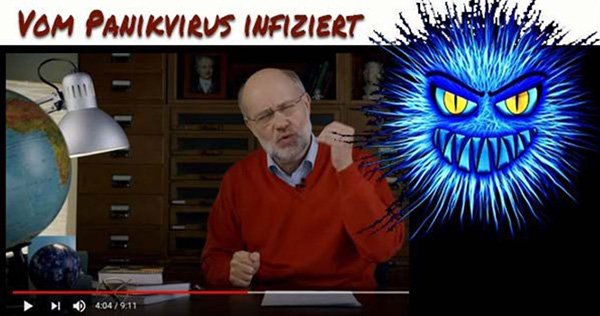by Dr.Harald Wiesendanger– Klartext
What the mainstream media is hiding
Amazing: Even the nation’s top TV teacher is now spreading fake news. The “exponential growth” with which he teaches his audience of millions to be frightened best characterizes the panic viruses with which he infected himself.

A 9-minute speech has been going viral since March 20, 2020, in which the nation’s TV enlightener, the astrophysicist and presenter Harald Lesch, tries to make it clear to us why the greatest concerns about Corona are appropriate and why the state’s “protective” measures are fully justified are. Within two days, the video clip was viewed over 2 million times – unfortunately, because Lesch is apparently now fully in the grip of the panic virus.

His five arguments are correspondingly poor:
1) Italy’s death statistics. With a population of 60 million, an average of 2,000 die there every day. “But on March 18th, there were 475 more – an increase of well over 20%!” says Lesch, horrified. The fact that within 365 days, each individual and many in a row can deviate from the statistical average, exceeding it more or less significantly, especially in a flu season: Is that sensational and deeply worrying? Seriously?
2) The mass extinction in Bergamo. With 120,000 inhabitants, Lesch reports, an average of 10 die per day. Currently, there are 20, so twice as many. Isn’t that really bad? Yes, of course – but statistically expected for the time being, so irrelevant, see point 1.) Did Lesch use Bergamo’s daily death numbers from early flu winters for comparison? Does he consider other possible factors? If so, he remains silent about it in the clip.
3) The amok argument. Even low numbers of victims justify immediate, drastic countermeasures, says Lesch. To do this, he uses a hair-raising comparison that can no longer limp because he is missing more than one leg: “If a gunman shoots 10 people, then we will do something, even though the people who were shot disappear into the statistics.”
Yes, of course, you should take action against it. But it has to be proportionate.
Do you impose a curfew on all potential amok targets as a precautionary measure?
4) The argument of the threat of “overtaxing the healthcare system.” A “total shortage situation” would force a so-called “triage”: a cruel sorting out of who gets ventilation and who doesn’t – “and that would be the end of civil society.” Then “many more patients arrive in the hospitals than can even be treated there.”
There are 28,000 intensive care beds available in Germany, half of which, i.e., 14,000, could currently be used to ventilate those infected with corona. On average, ventilation needs to be carried out for about a week – so 2,000 new patients could be cared for in this way every day. Lesch knows that the rate of new infections is increasing by a quarter to a third every day. So, with a 1/3 increase, 4,000 newly infected people today will become around 5,300 tomorrow and 7,000 the day after tomorrow. “And in 8 days, we would have 39,000 newly infected people – without countermeasures, with unchecked exponential growth.” And with a ¼ increase, that would be the healthcare system “reached its limits after 11 days.” According to Lesch, a point would then be reached where “eight times more intensive care beds would be needed than are available.”
Here, Lesch embarrassingly confuses “infection” and “disease.” Among those who have caught SARS-Cov-2 viruses, only a proportion develop any symptoms at all, and these are often mild. Almost only seniors, those with previous illnesses, and those with weak immune systems are in need of intensive therapy and in a life-threatening condition. The fact that “5% of those suffering from Covid-19 require ventilation” is a horror speculation that Lesch uses on all available head, chest, and pubic hair. And indeed, no studies prove that
Possibly, even one in 20 INFECTED people (5%) belongs in the intensive care bed. Of this
Starting from a hair-raising mix-up, Lesch fills his worry lines and ours with beads of fear. The government, authorities, WHO, institutes, and mainstream media have been trying to impress us with the same confusion since the beginning of the crisis. Yes, SARS-Cov-2 is spreading at lightning speed – as “flu” pathogens tend to do every year. And, as always, millions become infected – so what?
What is crucial is: Does this alleged “pandemic of the century” produce far more severe respiratory illnesses and deaths than normal flu waves of previous years? Lesch doesn’t provide a shred of evidence for this either. If he has empirical studies that support his alarmism, he successfully hides them for nine minutes.
And Lesch also tries to lead us to make a mistake in thinking that students learn to avoid in the first semester: short-circuiting correlation to causality. You can die WITH a virus without dying FROM it. A positive SARS-Cov2 test alone is clinically irrelevant. In how many cases were doctors able to plausibly determine that the SARS-Cov2 virus was solely responsible for the death of an infected person? I haven’t heard of a single one so far.
Placing sole blame on this coronavirus is not only wrong – because it distracts from other, no less important causes of death – but dangerously misleading. How come? Because it encourages hasty, foolish, largely useless countermeasures that cause incredible social and economic damage to all of us and the entire world. By the way, wherever a need can no longer be satisfied, demand is too high, and supply is too low. The more beds, the more ventilation technology, and the more staff, the smaller the treatment bottleneck. Anyone who unrestrainedly privatizes a health system, subjecting it to profit maximization and making savings wherever possible, should not be surprised if it quickly reaches its limits.
5) The spooky extrapolation of Imperial College London. Without any government countermeasures, we are told that Covid-19 would lead to 500,000 deaths in Great Britain alone and 2.2 million in the USA. Even WITH the most severe cuts, the death rate could, at best, be halved.
Here, as with argument 4), number crunchers create a sense of panic and incite measures that are in no way supported by the currently available epidemiological data. In truth, NO ONE knows yet how many people are already infected, how quickly the infection spreads in the general population, how high the proportion of seriously ill people is, and how many of them would actually require intensive care. To do this, a representative sample of the general population would have to be tested repeatedly and monitored continuously. Nowhere, not even in Germany, Great Britain and the USA, has such monitoring taken place so far. Instead, the focus is on people who have already become conspicuous due to symptoms and their contacts; you check the sick, the seriously ill, and the dead. This selection bias creates enormous uncertainty about the true risk of dying from Covid-19.
And so Lesch’s wisest sentence may have been his very first: “We may be talking about something today that we will only be able to smile mildly about in a month.”
(Harald Wiesendanger)
See original post
